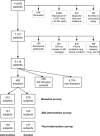Effectiveness of an on-call counselor at increasing smoking treatment
- PMID: 17530311
- PMCID: PMC2305728
- DOI: 10.1007/s11606-007-0232-2
Effectiveness of an on-call counselor at increasing smoking treatment
Abstract
Background: Smoking cessation programs are very effective, but little is known about how to get smokers to attend these programs.
Objective: To evaluate whether an "on-call" counselor increased smoking cessation program referrals and attendance.
Design: We randomly assigned 1 of 2 primary care teams at the Sepulveda VA Ambulatory Care Center to intervention and the other to usual care. The intervention team had access to an on-call counselor who provided counseling and care coordination. Social marketing efforts included educational outreach, provider feedback, and financial incentives.
Measurements: Baseline telephone interviews with a sample of 482 smokers were conducted, covering smoking history, health status, and smoking cessation treatments. Follow-up surveys were conducted at mid-intervention (n = 251) and post-intervention (n = 251).
Results: Two hundred ninety-six patients were referred to the on-call counselor, who counseled each patient in person and provided follow-up calls. The counselor referred 45% to the on-site program, and 27% to telephone counseling; of these, half followed through on the referral; 28% declined referral. Patients on the intervention team were more likely to report being counseled about smoking (68% vs 56%; odds ratio [OR] 1.7, CI 1.0-2.9) and referred to a cessation program (38% vs 23%; OR 2.1, CI 1.2-3.6); having attended the program (11% vs 4%; OR 3.6, CI 1.2-10.5); and receiving a prescription for bupropion (17% vs 8%) (OR 2.3, CI 1.1-5.1). The effect was not sustained after the case management period.
Conclusions: Having access to an on-call counselor with case management increased rates of smoking cessation counseling, referral, and treatment. The intervention could be reproduced by other health care systems.
Figures
References
-
- {'text': '', 'ref_index': 1, 'ids': [{'type': 'DOI', 'value': '10.1016/S0749-3797(01)00308-7', 'is_inner': False, 'url': 'https://doi.org/10.1016/s0749-3797(01)00308-7'}, {'type': 'PubMed', 'value': '11418251', 'is_inner': True, 'url': 'https://pubmed.ncbi.nlm.nih.gov/11418251/'}]}
- Coffield AB, Maciosek MV, McGinnis JM, et al. Priorities among recommended clinical preventive services. Am J Prev Med. 2001;21:1–9. - PubMed
-
- {'text': '', 'ref_index': 1, 'ids': [{'type': 'PubMed', 'value': '15726855', 'is_inner': True, 'url': 'https://pubmed.ncbi.nlm.nih.gov/15726855/'}]}
- Jonk YC, Sherman SE, Fu SS, Hamlett-Berry KW, Geraci MC, Joseph AM. National trends in the provision of smoking cessation aids within the Veterans Health Administration. Am J Manag Care 2005;11:77–85. - PubMed
-
- Fiore MC, Bailey WC, Cohen SJ, et al. Treating Tobacco Use and Dependence. Clinical Practice Guideline. Rockville, MD: U.S. Department of Health and Human Services, Public Health Service; June 2000.
-
- {'text': '', 'ref_index': 1, 'ids': [{'type': 'DOI', 'value': '10.1016/S0749-3797(00)00124-0', 'is_inner': False, 'url': 'https://doi.org/10.1016/s0749-3797(00)00124-0'}, {'type': 'PubMed', 'value': '10788733', 'is_inner': True, 'url': 'https://pubmed.ncbi.nlm.nih.gov/10788733/'}]}
- Zhu S, Melcer T, Sun J, Rosbrook B, Pierce JP. Smoking cessation with and without assistance: a population-based analysis. Am J Prev Med. 2000;18:305–11. - PubMed
-
- Office of Quality and Performance, Veterans Health Administration. Health Behaviors of Veterans in the VHA: Tobacco Use. 1999 Large Health Survey of Enrollees. October 2001.
Publication types
MeSH terms
LinkOut - more resources
Full Text Sources
Medical
Miscellaneous



